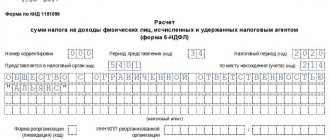What is a liquidation balance sheet
There is no separate interpretation for the concept of “liquidation balance” in the event of voluntary termination of economic activity or bankruptcy in the regulations of the Russian Federation. Article 63 of the Civil Code mentions it as one of the step-by-step stages of closing a legal entity:
- Publication of an information message about liquidation, timing and procedure for filing claims.
- Formation of a register of creditors and preparation of interim liquidation financial statements.
- Sale of all company assets.
- Carrying out settlements with creditors.
- Drawing up the final liquidation balance sheet (according to the Ministry of Finance, set out in paragraph 2 of Letter No. GD-4-14/ [email protected] , it should not contain data on any types of debts).
Quote ^ “The liquidation balance sheet provides for the absence in it of information about accounts payable in any amount” (letter of the Federal Tax Service No. GD-4-14 / [email protected] ).
Composition of interim reporting data of an enterprise
Enterprises use a form independently developed to generate data. The basis is the standard document balance sheet form 1 or interim reporting, developed for banks with detailed turnover for each item.
Information not reflected on balance sheet items as clarifying information is given in appendices to the form. The explanations provide detailed information about accounts payable, receivables, property, other assets and other important information. Applications are stitched together with the balance.
When forming indicators, data from previous reporting and inventory carried out by the organization are used. The balance sheet must reflect information about the assets and debts of the enterprise in expanded form.
The table contains information that supplements the cost estimate.
| Intelligence | Information supplementing the valuation |
| Fixed assets – buildings and structures, equipment | Account number, name, location (for buildings), year of registration, wear and tear, depreciation, residual value |
| Construction in progress | Name, year the construction began, description of the stage, cost |
| Financial investments | Purpose, types |
| NMA | Name |
| Reserves | Name, grouping by inventory, finished products, VAT and others |
| Accounts receivable, advances issued, short-term investments | Types, condition, list of redemption dates |
| Cash | Grouping by storage location |
| Authorized capital, retained earnings, if any | The value must correspond to that stated in the Charter |
| Credits, loans, other accounts payable | Types, grouping by requirements in order of priority, repayment periods and amounts, if any - court decisions |
| Arrears of wages, severance pay and taxes | Types, amounts, terms of payments |
Types of liquidation balance sheet
After the decision to close the company is approved, the founders appoint a liquidator or a commission of several specialists who must streamline the process and manage as efficiently as possible the property that remains and can be sold.
They are the ones who accept claims from suppliers and other creditors, draw up a register and determine the order of their repayment. Their responsibilities include preparing the latest financial statements. It includes two types of liquidation balance sheet:
- intermediate;
- final.
Intermediate
After publishing a notice of termination of activities, the liquidator is obliged to comply with the mandatory period allotted for accepting claims from creditors (at least 2 months), Art. 22 of Law No. 129-FZ. Information received from borrowers will be reflected in the liability side of the interim liquidation balance sheet (on what date it is compiled is not specified in the law, but not earlier than 2 months after the publication of the announcement in the State Registration Bulletin).
Sources for debt payment are formed on the basis of accounting data and extraordinary inventory. Summary information about accounts payable and liquid assets is first presented in the interim liquidation balance sheet.
The registration authority must be notified of its preparation (another application is submitted in form P15001. The need to attach a copy of the financial report to it is not provided for by law, Article 20 of Law No. 129-FZ). However, it is necessary to report on the summing up of interim results no later than 3 days after its approval at the general meetings.
The Federal Tax Service expressed its opinion on the form in which the latest reporting of a legal entity should be submitted in Letter No. ВД-4-1/ [email protected]
The document does not mention how to draw up an interim liquidation balance sheet and which form to use, but the company can use, for example, the OKUD form 0710001. Since the law does not oblige a business entity to submit one copy of this document to the Federal Tax Service, claims regarding “ Inspectors cannot have the wrong form.
Responsible representatives of the commission during the liquidation of an LLC can use the current sample interim balance sheet:
The interim liquidation balance sheet can be approved several times, as necessary
A convenient typewritten form can be downloaded here:
Final
After the period allotted for closing the legal entity has passed (but not earlier than 60 days) and after all activities have been completed and creditors’ claims have been settled, a final balance sheet is drawn up. It differs from the intermediate one in that there cannot be balances (outstanding debt) in the sections “Long-term liabilities” and “Short-term liabilities”.
The assets of the final document should provide information about:
- the book value of the property that remains after repayment of debts;
- cash and securities purchased in the name of the company;
- accounts receivable, which the liquidation commission assessed as potentially recoverable (bad debt is usually written off at the stage of compiling interim results);
- other liquid stocks and objects that can be distributed among the founders.
Important! Unlike the interim, the final financial report is drawn up only once, when all issues with borrowers and government agencies have already been resolved (debts have been paid, tax audits have been completed, court decisions have entered into force).
As part of the reporting for 2021, the liquidation balance sheet forms KND 0710095 and KND 0710094 (simplified version) are used, approved by the Federal Tax Service in Letter No. VD-4-1 / [email protected] along with other samples of filling out forms and a description of their structure.
A copy of the compiled document is submitted to the registration department of the Federal Tax Service along with an application in form P16001 within 3 days after its approval at the meeting of co-founders.
The final liquidation balance sheet is compiled in accordance with the approved rules and forms
The procedure for liquidating organizations
According to Art. 61 of the Civil Code of the Russian Federation, the closure of a company is carried out with the cessation of its functioning without transfer of rights of use and ownership to third parties. Closing a company can be voluntary or forced.
How to properly reorganize a company:
The decision to liquidate on a voluntary basis is made by the founders, who must be part of the liquidation commission. The process of forced closure of a company is initiated by creditors or supervisory authorities and occurs through the courts.
The decision to liquidate the organization
There are several reasons why a business may close:
- bankruptcy;
- business mergers or restructuring;
- closure of an organization by a voluntary decision of the owner;
- termination of existing activities;
- conducting activities that do not correspond to the direction of the enterprise.
Closing a company is a complex and lengthy process. Drawing up a liquidation balance sheet will be one of its main stages
What does the algorithm for closing a company look like?
- Assessment of the company's property status.
- Cost accounting.
- Compilation of a register of creditors' claims and consideration of claims.
- Interim liquidation balance sheet.
- Sale of existing assets.
- Accounting for expenses of bankruptcy proceedings.
- Satisfaction of creditors' demands.
- Preparation of liquidation balance sheet.
- Liquidation of the enterprise.
The first step towards liquidating an organization will be a meeting of shareholders and founders, at which they will decide to close it. The decision made is recorded in the protocol. If the company has debtors, then it is necessary to develop a mechanism for repaying debts and determine the timing of settlement of obligations.
The second step should be the appointment of a liquidation commission. The rights to manage the organization will be transferred to her. The commission is obliged to warn creditors about the date of closure of the company.
Next, a package of documents is submitted to the tax service:
- decision to appoint a liquidation commission;
- completed form P15001.
The last document must be certified by a notary. To do this, the specialist will require the following documents:
- extract from the registration register;
- articles of association;
- TIN and OGRN certificates;
- protocol on the appointment of the head of the company.
Sample of filling out form P15001
The form is filled out according to the same rules that apply for preparing tax reports. Namely: it is customary to fill out the form typewritten, in capital letters; dashes should not be made in empty columns.
This form P15001 is a document confirming the liquidation of the enterprise
It is necessary to inform interested parties about the closure of the enterprise: for this you should advertise in the newspaper.
If the LLC does not have a debt obligation, the tax service will coordinate the timing of inspections with government agencies. Based on the results of fulfillment of obligations, an interim LP is formed between the company and creditors.
Read all the details about the LLC reorganization in this article:
Rules and procedure for drawing up a liquidation balance sheet
The legislation does not define separate rules for the preparation of the latest financial accounting statements. When forming it, you still need to use:
- national accounting regulations (PBU);
- Law No. 402-FZ - on accounting in Russia;
- recommendations for filling out financial statements - Order of the Ministry of Finance No. 34n;
- table of forms for submitting reports - Order of the Ministry of Finance No. 66n.
The sequential process of drawing up entries to reset the balance and form accounting records during the liquidation of an enterprise must be built in accordance with the requirements set out in the Instructions for the use of accounts (Order of the Ministry of Finance 94n) and the Regulations on the accounting policies of the legal entity itself, Art. 8 of Law No. 402-FZ.
Step-by-step instructions for calculating balance indicators
When forming indicators, accounting rules applicable to the liquidation stage are used. In the process of data preparation, the following actions are performed:
- Making adjustments to accounting policies.
- Changing the criteria for classifying long-term and short-term debt. In case of liquidation before the expiration of 12 months, long-term debt is transferred to short-term debt.
- Termination of depreciation accrual due to the cessation of use of objects in activities and the loss of criteria for classification as intangible assets and fixed assets.
- Write-off of intangible assets that are not capable of generating income, for example, business reputation.
- Supplementing the work plan with accounts for accounting for tangible assets 30 “intended for sale” and 31 “intended for distribution between owners.”
- Reformation of accounting items for income and expenses of future periods, deferred tax assets and liabilities.
Additionally, a redistribution of asset groups is carried out into cash, accounts receivable, property and inventory planned for sale and distribution between owners.
Features of drawing up a liquidation balance sheet
Drawing up the latest financial statements allows the liquidator to correctly assess the financial position of the company, as well as the potential risks for its creditors and co-founders. In general, the procedure might look like this:
- Carrying out an inventory in order to identify actual balances and establish the real estimated value of the legal entity’s property.
- Recognition and agreement of the amount of creditors' claims.
- Formation of interim results and notification of inspectors of the Federal Tax Service about the start of activities for the sale of assets and repayment of debts.
- Drawing up the final liquidation balance sheet with zero indicators in the sections on liabilities (during the liquidation of the LLC in 2019, the samples approved in Order No. 66n and Letter No. VD-4-1 / [email protected] ).
It is noteworthy that interim reporting can be prepared several times, as the need arises to change indicators based on the results of the liquidator’s work. This may happen due to:
- revaluation of the value of inventories and objects;
- reaching an agreement with creditors;
- identifying new circumstances that could change balance sheet amounts.
The number of intermediate balances is not limited by law. However, do not forget that each of the approved documents must be reported to the Federal Tax Service within 3 days from the date following the preparation of the minutes of the general meeting.
Liquidation of an LLC with one participant
The liquidation process of an LLC is regulated by Art. 61–65 of the Civil Code. An LLC with one founder can be liquidated provided that:
- the company has no debts - to individuals and legal entities, as well as to the Pension Fund, the Federal Tax Service (FTS), the Social Insurance Fund and other structures,
- Mandatory reporting was submitted to the tax office in a timely manner.
When liquidating an LLC, it is necessary to notify the staff of the dismissal two months before the actual day of termination of the employment contract.
Drawing up a protocol on approval of the liquidation balance sheet
The job of the liquidator or commission is not only to accept claims and compile statutory reports. Members of the liquidation team and those responsible for accounting must go through the procedure for approving the financial report at a meeting of the founders. For each version of the final document there must be a separate protocol, which reflects the agreement of the company’s owners with the data reflected in it:
- on the size and composition of debts;
- on ways and sources of satisfying creditors' claims;
- on inventory and revaluation data of property;
- on the composition of objects that can be sold at book value and fixed assets in respect of which tenders will have to be held;
- about the amounts of profit and loss.
Obtaining the consent of the majority of co-sponsors may require additional clarification that will not be reflected in the final protocol.
Sample protocol on approval of the interim liquidation balance sheet
Protocol on approval of the final version of the accounting document
There is no need to provide a copy of the document to the registration service (Article 21 of Law No. 129-FZ has no such requirements), you just need to indicate the number and date of the meeting in the balance sheet header. In practice, tax authorities still require a copy of the protocol to be verified for themselves that the application deadlines have been met.
Programs for drawing up an interim balance sheet during liquidation
To generate reporting, organizations use specialized programs adapted to individual conditions. When using the standard balance sheet form as a basis, businesses can use:
- "BALANCE-NETWORK". In the program you can set up a working chart of accounts, keep records using double entry, display balances and create turnover sheets.
- Balance-2W. The program has an additional function for generating reports taking into account the formulas used during desk audits.
- 1C. The program is the most common among users with a wide range of configurations and great capabilities, including a manual mode for adjusting indicators.
Reporting is generated in electronic form and can be printed or downloaded for transmission via communications.
Should the liquidation balance be zero?
The characteristic “liquidation” in the title of the report does not mean that it should automatically be zero (that is, one where there are no indicators in the asset and liability sections). The latest financial statements simply should not contain data on the company’s debts to creditors, personnel or government agencies. The liability may only contain information about the amount of undivided profit or uncovered losses.
The liquidator has the right to distribute property and cash balances before submitting form P16001 to the state registration authorities. Then, in the final liquidation balance sheet, zero indicators will appear in absolutely all cells (in 2021, the sample filling will be changed, however, at the request of the company, the new form approved in Order 61n of 2021 can be used now).
Differences between interim and final liquidation reporting
The information presented in the interim and final balance sheets differs.
| Condition | Interim balance | Final balance |
| Lack of data in reporting | Zero reporting is not submitted | Zero reporting |
| Quantity | Can be more than one form | Submitted once |
| Dependence of indicators | Do not depend on final reporting | To reflect the opening balances, the closing balances of interim reporting are used |
| Obligation to submit to the Federal Tax Service | May not be visible to external users | Must be submitted |
| Date of reporting | Any of the dates, for example, the day of the end of the period for presenting claims of creditors before settlements with the founders | Date preceding the exclusion of the enterprise from the register |
Consequences of the formation of zero and non-zero balances
The legislation does not oblige the liquidator to distribute the balances between the owners before making a record of the liquidation of the legal entity in the Unified State Register of Legal Entities. This can be done later, especially if the company’s assets have outstanding receivables that can be returned or sold (albeit at a discount).
| The essence of the reflected information | Consequences |
| There are no numbers other than zero in the asset or liability of the report | This means that the company has completely paid off its debts and distributed the remaining property between the co-founders without disputes. In addition, the liquidator managed to return all the money that was listed as receivables |
| Zero indicators are included only in liability sections reflecting the obligations of the legal entity | This situation may arise in a situation where the founders have not agreed on the division of fixed assets and inventories. If the undistributed property includes objects in respect of which transport or property taxes are charged, then the application for liquidation may not be accepted at all until new persons are identified who are responsible for transferring contributions to the budget |
| Non-zero data is present in all sections of the liability | Application P16001, to which such reporting is attached, will be refused. The liquidator will have to either reach an agreement with the creditors, or offer the co-founders to pay with their own funds, or initiate bankruptcy proceedings in accordance with Law No. 127-FZ |
Order a free legal consultation









